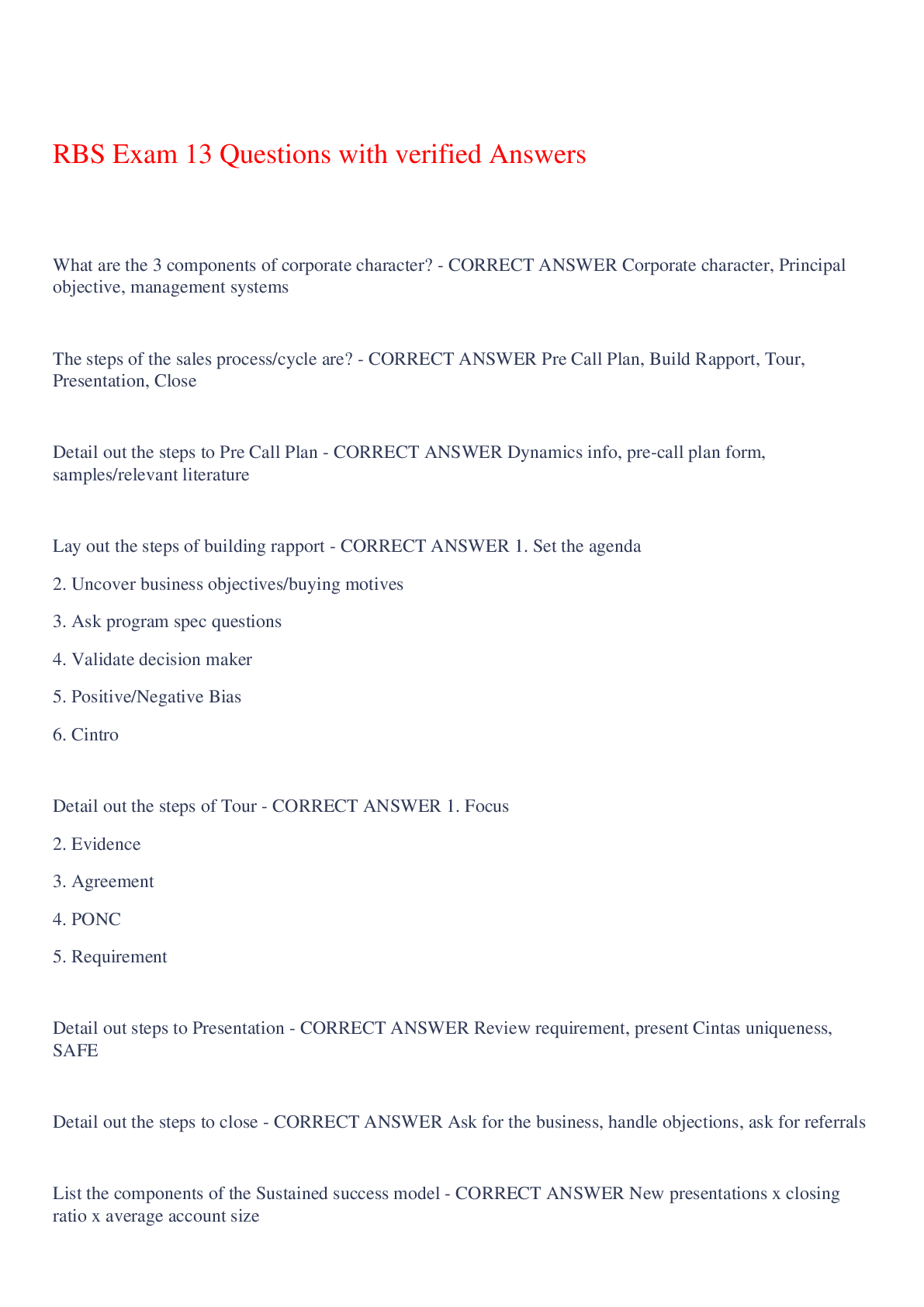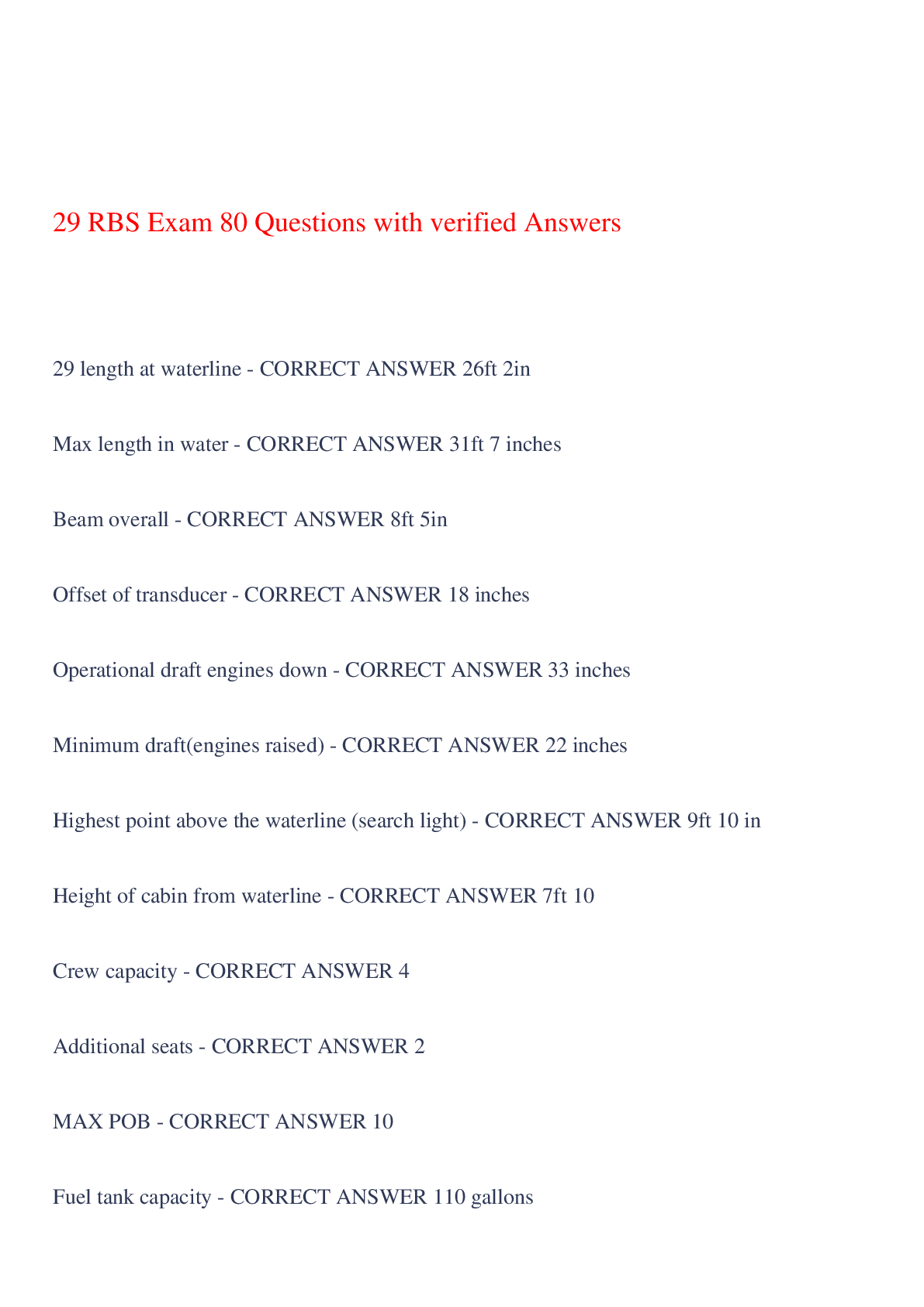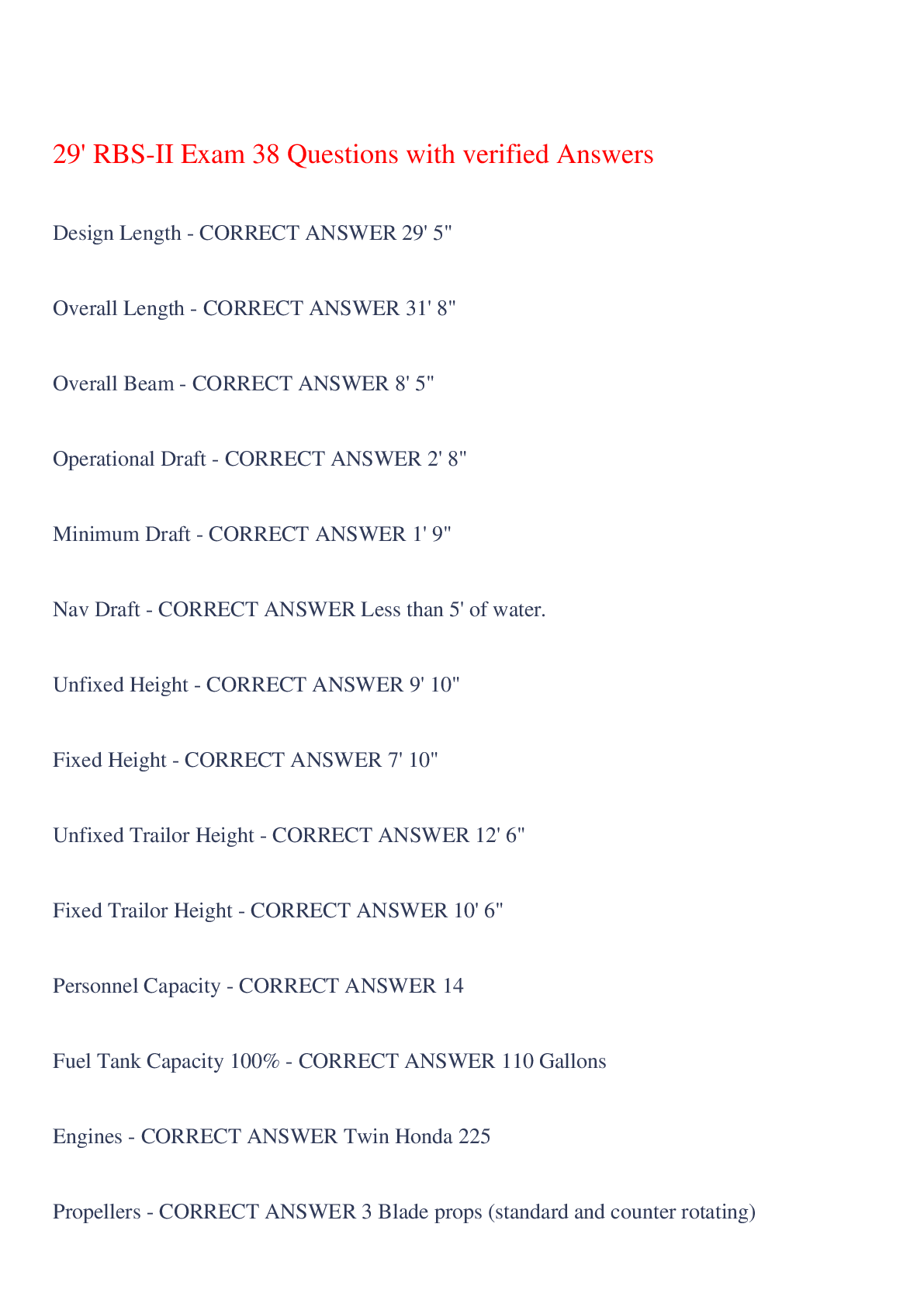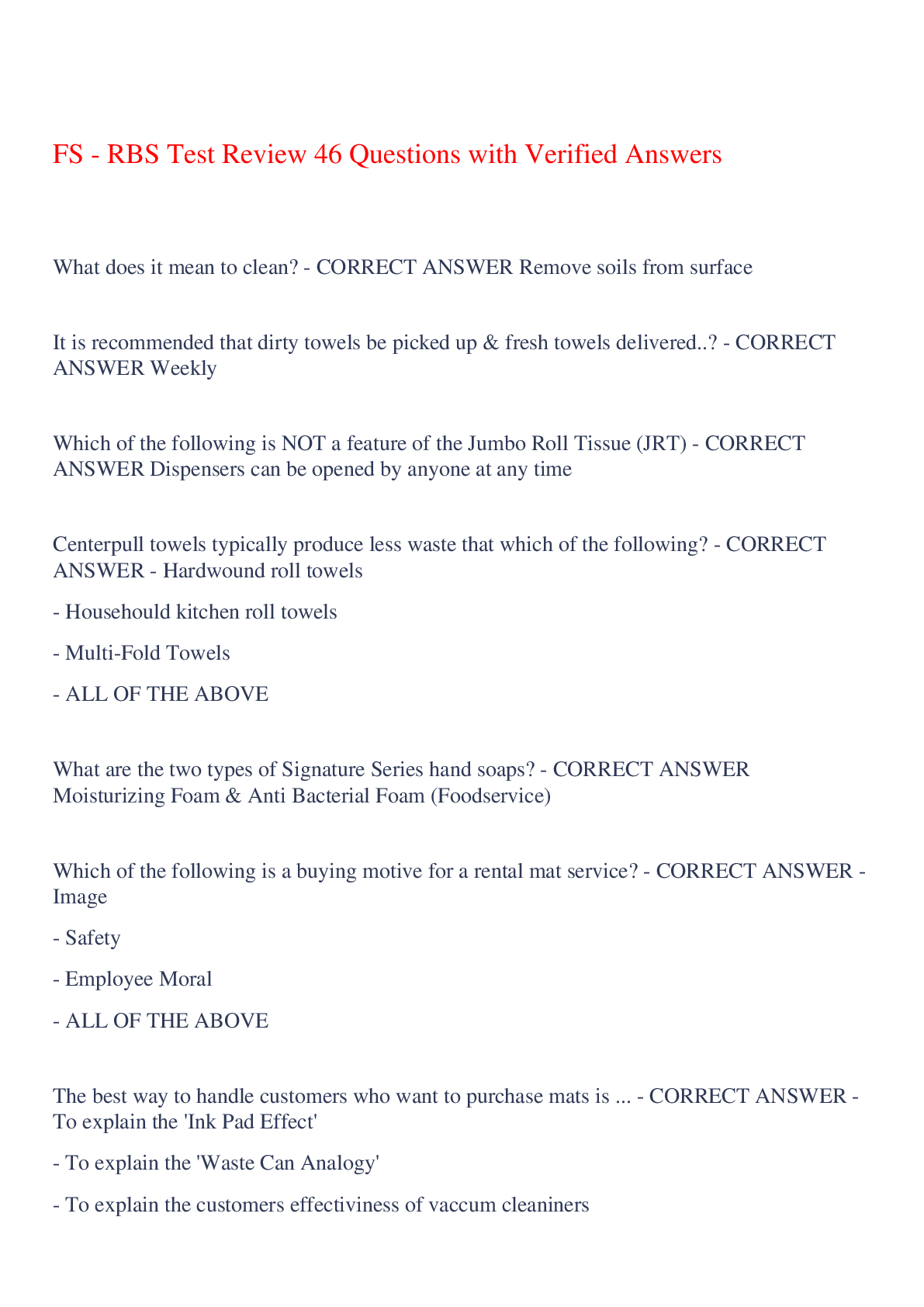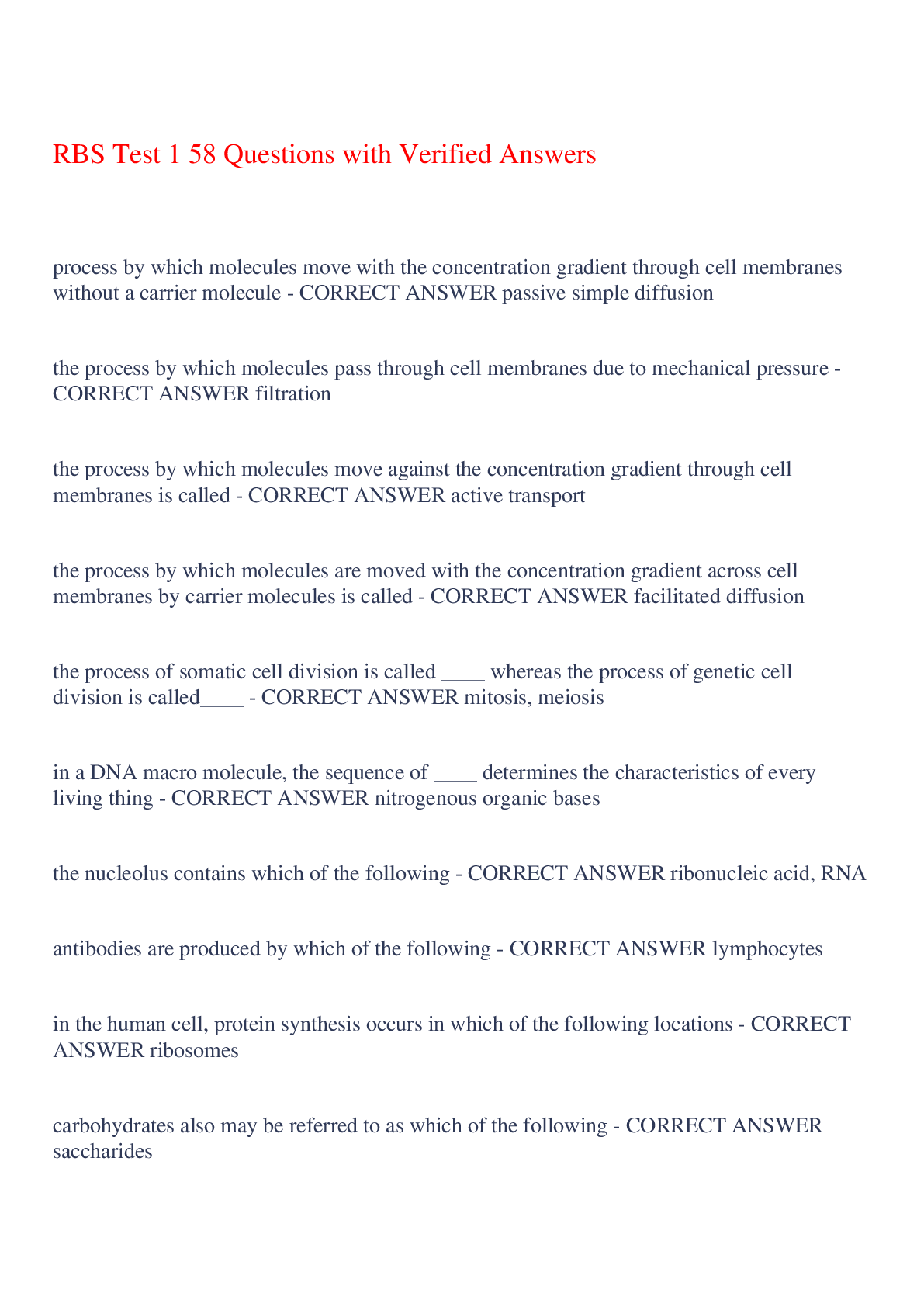ARDMS practice Test 100 Questions with Verified Answers,100% CORRECT
Document Content and Description Below
ARDMS practice Test 100 Questions with Verified Answers Sonographers should be aware of work-related musculoskeletal disorders. Best practice while scanning is to avoid abducting the arm more than ... how many degrees? a. 50 b. 90 c. 30 d. 40 - CORRECT ANSWER c. 30 Which action demonstrates best practice during ultrasound exams regarding the ALARA principle? a. The exposure time should be extended during the exam. b. use the lowest possible output power that provides a diagnostic image. c. use the lowest possible gain. d. Ensure that the time gain compensation (TGC is within acceptable limits. - CORRECT ANSWER b. use the lowest possible output power that provides a diagnostic image Which type of cavitation is the most concerning cause of bioeffects? a. Transient b. Absorption c. Stable d. Thermal - CORRECT ANSWER a. transient Assuming an unfocused ultrasound beam, the American Institute of ultrasound in Medicine's "statement on Mammalian Biological Effects of ultrasound In vivo" has confirmed that no bioeffects have been noted when the spatial pulse temporal average (SPTA) intensity is less than which value? a. 1 mW/cm2 b. 100 W/cm2 c. 1 W/cm2 d. 100 mW/cm2 - CORRECT ANSWER d. 100 mW/cm2 A sonographer notices that the mechanical index (MI) is too high during an ultrasound. What would be the MOST appropriate modification that the sonographer can make? a. decrease receiver gain b. increase period c. decrease the output power d. decrease the frequency of the transducer - CORRECT ANSWER c. decrease the output power Select the technique that will generate the LEAST amount of exposure to the patient. a. Spectral Doppler b. Color flow Doppler c. Grayscale d. M-mode - CORRECT ANSWER c. grayscale When a vibrating string or fluid pump is used to test system performance, what parameter is being tested? a. Dead zone b. Doppler velocities c. Contrast resolution d. Grayscale sensitivity - CORRECT ANSWER b. Doppler velocities A tissue-equivalent phantom is used to ensure the efficiency of the ultrasound machine. Choose the resolution that is NOT tested with this phantom. a. Temporal b. Contrast c. Axial d. Horizontal - CORRECT ANSWER a. temporal Which performance check describes the ability of the ultrasound machine to correctly visualize signals that are weaker than others? a. Accuracy b. Specificity c. Reliability d. Sensitivity - CORRECT ANSWER d. sensitivity What is the name of the recent technological advancement that is used on tissues such as the liver, breast, prostate, and thyroid to assess the stiffness of tissue or to better assess lesions? a. Contrast-enhanced ultrasound b. Fusion imaging c. Elastography d. Harmonics - CORRECT ANSWER c. elastography Which choice is NOT a true statement regarding this filling defect within the gallbladder? a. The filling defect displays a significant amount of attenuation. b. it has created an enhancement artifact. c. It has created a shadowing artifact d. Regions deeper than the filling defect are obscured. - CORRECT ANSWER b. it has created an enhancement artifact Which type of artifact appears echogenic and stems from gas bubbles as they vibrate due to the interaction with the ultrasound beam? a. Ring-down artifact b. edge shadow c. Crosstalk d. Slice thickness - CORRECT ANSWER a. ring-down artifact What is the fundamental reason that the power and intensity of the ultrasound beam diminish as it travels through tissue? a. Absorption b. Cavitation c. Obstruction d. Acoustic impedance - CORRECT ANSWER a. absorption Select the modification that the sonographer can make to decrease the amount of attenuation as the ultrasound beam travels through tissues. a. Increase the imaging depth. b. Increase the frequency of the transducer. c. Decrease the output power. d. Decrease the frequency of the transducer. - CORRECT ANSWER d. decrease the frequency of the transducer Choose the ultrasound system function that enables the sonographer to adapt to the amount of attenuation that occurs with increasing depth. a. Focusing b. Receiver gain c. TGC d. Output power - CORRECT ANSWER c. TGC Assume that a sound beam is traveling in soft tissue. Calculate the attenuation coefficient if the frequency is 12 MHz. a. 12dB/cm b. 6 dB/cm c. 8 dB/cm d. 10 dB/cm - CORRECT ANSWER b. 6 dB/cm What is NOT a component of attenuation? a. Reflection b. Scattering c. Resolution d. Absorption - CORRECT ANSWER c. resolution Impedance is NOT influenced by which component? a. The frequency of the transducer b. Density c. Propagation speed d. Stiffness - CORRECT ANSWER a. the frequency of the transducer For reflection to take place, which situation must exist? a. The border of two different tissues must have different impedances. b. There must be Iittle difference of the impedances at soft-tissue boundaries. c. Normal incidence and identical impedances must be present d. Oblique incidence must occur. - CORRECT ANSWER a. The border of two different tissues must have different impedances. While assuming continuous wave (cw) ultrasound, what is the duty factor (DF)? a. 0.2% b. l% c. 0% d. 100% - CORRECT ANSWER d. 100% What will happen to the duty factor (DF) if the system increases the pulse repetition frequency (PRF) ? a. DF remains the same. b. DF increases. c. DF is not related to PRF. d. DF decreases. - CORRECT ANSWER b. DF increases The best axial resolution will be apparent if the sonographer performs an exam with a transducer that has which characteristic? a. Longer pulse length b. Longer wavelength c. Shorter pulse length d. More ringing in the pulse - CORRECT ANSWER c. Shorter pulse length Lateral resolution will be improved if the sonographer performs which operation? a. Decreases the scanning depth b. Increases the number of focal zones c. Maximizes the output power d. Uses a lower frequency - CORRECT ANSWER b. Increases the number of focal zones Which action will NOT increase (or improve) temporal resolution? a. Increase the imaging depth. b. Decrease the number of focal zones. c. Use a sector size that is narrow. d. Use a low line density. - CORRECT ANSWER a. Increase the imaging depth. Which name describes how the angles of the incident and transmission beams are related to the speed of the two media? a. Bernoulli's principle b. Curie point c. Huygens' principle d. Snell's law - CORRECT ANSWER d. Snell's law What can be done when investigating a possible kidney stone to better demonstrate shadowing from the stone when using a 3 MHz probe? a. Position the focal point deeper than the stone. b. Increase the amount of gain. c. Increase the frequency to 5 MHz. d. Decrease the output power of the system. - CORRECT ANSWER c. Increase the frequency to 5 MHz If the frequency is doubled, what effect will this have on the wavelength? a. It will remain the same. b. It doubles. c. It increases by a factor of 1.54. d. It is halved. - CORRECT ANSWER d. It is halved. Which part of the transducer is necessary to reduce the amount of ringing of the piezoelectric (PZT) crystal? a. Matching layer b. Backing material c. Transducer housing d. Wire - CORRECT ANSWER b. Backing material A given frequency of sound is 4.5 MHz, and it has a wavelength of 0.8 mm. How thick should a manufacturer design the matching layer of a transducer in this scenario? a. 0.4 mm b. 0.16 mm c. 0.2 mm d. 0.6 mm - CORRECT ANSWER c. 0.2 mm A sonographer is performing a renal ultrasound. Which transducer frequency will generate the slowest speed of sound? a. All frequencies will travel at the same speed in the same tissue. b. 2 MHz c. 4.5 MHz d. 7 MHz - CORRECT ANSWER a. All frequencies will travel at the same speed in the same tissue. Transducers used in image production will have which characteristics? a. High Q-factor, wide bandwidth b. Low Q-factor, wide bandwidth c. Low Q-factor, narrow bandwidth d. High Q-factor, narrow bandwidth - CORRECT ANSWER b. Low Q-factor, wide bandwidth Which transducer produced the shape of this image? a. Linear sequential array b. Vector array c. Annular phased array d. Convex array - CORRECT ANSWER d. Convex array This malfunction takes place in which kind of transducer? a. Linear sequential array b. Annular phased array c. Convex sequential array d. Mechanical - CORRECT ANSWER b. Annular phased array Which statement is NOT true of a linear phased array transducer? a. The footprint tends to be small. b. It can alter the number of focal zones and the depth. c. The image is a rectangle. d. It uses electronic steering. - CORRECT ANSWER c. The image is a rectangle. Select the type of transducer that enables multi-focusing while being steered mechanically. a. Annular phased array b. Mechanical c. Linear sequential array d. Convex sequential array - CORRECT ANSWER a. Annular phased array If the diameter of the PZT crystal is 13 mm, which sentence describes the sound wave's diameter in the Fresnel zone? a. The sound beam will be half of the diameter of the crystal in the Fresnel zone. b. 13 mm c. 26 mm d. The sound wave narrows as it leaves the transducer. - CORRECT ANSWER d. The sound wave narrows as it leaves the transducer. The amount of divergence that occurs in the far field is determined by the sound wave's frequency and which component? a. Line density b. Focal zone depth c. Diameter of the crystal d. Speed - CORRECT ANSWER c. Diameter of the crystal Select the type of transducer that produces an image that takes on the shape of a parallelogram when it is electronically steered. a. Linear phased array b. Linear sequential array c. Annular phased array d. Convex array - CORRECT ANSWER b. Linear sequential array Choose the type of transducer that lacks range resolution. a. Phased array b. Annular array c. Continuous wave (CW) d. Linear sequential array - CORRECT ANSWER c. Continuous wave (CW) In this phased array transducer, what direction will the beam be steered? a. 45 degrees to the right b. Slightly to the left c. Slightly to the right d. 45 degrees to the left - CORRECT ANSWER d. 45 degrees to the left What configuration is necessary to focus the ultrasound wave in a linear phased array transducer? a. Electronic slope b. Dynamic aperture c. PZT crystals d. Electronic curve - CORRECT ANSWER d. Electronic curve Which parameter is decreased by the ultrasound machine to evade the possibility of range ambiguity when the imaging depth is increased? a. Number of scan lines b. Pulse repetition frequency (PRF) c. Pulse repetition period (PRP) d. Persistence - CORRECT ANSWER b. Pulse repetition frequency (PRF) Which phrase does NOT describe an effect that focusing has on the ultrasound beam? a. A bigger focal zone b. Enhanced near zone resolution c. Diminished lateral resolution of the far zone d. Results in a shorter near zone - CORRECT ANSWER a. A bigger focal zone Select the answer that best describes how B-mode will typically display blood vessels? a. Hyperechoic b. Isogenic c. Anechoic d. Heterogeneous - CORRECT ANSWER c. Anechoic How deep is a reflector if the go-return time of a sound wave is 39 us? a. 2cm b. 3cm c. 5cm d. 6cm - CORRECT ANSWER b. 3cm Why does grayscale imaging require the use of pulsed wave ultrasound? a. To optimize penetration b. To optimize temporal resolution c. To determine the bandwidth d. To determine the depth of the reflector - CORRECT ANSWER d. To determine the depth of the reflector Which system function is modified if the ultrasound user adjusts the receiver gain? a. Demodulation b. Reject c. Amplification d. Compression - CORRECT ANSWER c. Amplification When M-mode is employed during an echocardiogram, what information is depicted on the display? a. Depth and amplitude b. Time and frequency c. Amplitude, motion, and time d. Depth, time, and frequency - CORRECT ANSWER c. Amplitude, motion, and time If an ultrasound image displays high contrast, what correlates with the dynamic range? a. Wide dynamic range b. Narrow dynamic range c. No effect on the range d. A display of many shades of gray - CORRECT ANSWER b. Narrow dynamic range Which component of the ultrasound wave increases if the sonographer increases the output gain? a. Pulse duration b. Frequency c. Noise d. Intensity - CORRECT ANSWER d. Intensity What is the name of the frequency used in tissue harmonics that is responsible for image production? a. Fundamental frequency b. Spatial compounding c. Overall gain d. Harmonic frequency - CORRECT ANSWER a. Fundamental frequency Which one of the following applies when using tissue harmonics to image the gallbladder? a. Use of lower frequencies b. Use of higher frequencies c. Decreased lateral resolution d. Increased reverberation artifacts - CORRECT ANSWER b. Use of higher frequencies Which type of zoom is a preprocessing function that provides more pixels in the region of interest, resulting in superior spatial resolution? a. Temporal resolution b. Read zoom c. Write zoom d. Read magnification - CORRECT ANSWER c. Write zoom Which control on the ultrasound system should be adjusted if it is necessary to reduce the amount of noise in the image? a. Reject b. Amplification c. Compression d. Demodulation - CORRECT ANSWER a. Reject During a renal ultrasound, the sonographer finds it necessary to adjust controls on the ultrasound system to improve the image. What CANNOT be adjusted by the operator? a. Output power b. Amplitude c. Frequency d. Speed - CORRECT ANSWER d. Speed What control offers better visualization of fibroids by increasing penetration far field and resolution? a. Persistence b. Spatial compounding c. Coded excitation d. Elastography - CORRECT ANSWER c. Coded excitation Which control can a sonographer apply to help delineate a subtle liver mass? a. Zoom b. Edge enhancement c. Fill-in interpolation d. Increase the receiver gain - CORRECT ANSWER b. Edge enhancement Which phrase correctly describes the following ultrasound beam? a. Unfocused, no steering b. Focused, steered to the right c. Unfocused, steered to the left d. Focused, steered to the left - CORRECT ANSWER d. Focused, steered to the left What is the name of the approach to image production in which the reflected ultrasound beam is averaged among multiple frequencies to lessen the effects of noise and speckle in the image? a. Spatial compounding b. Tissue harmonics c. Frequency compounding d. Temporal compounding - CORRECT ANSWER c. Frequency compounding What is a function of the receiver? a. It shapes the ultrasound beam. b. It controls the collaboration of the synergy of the ultrasound components. c. It stores images and video clips. d. It changes and displays the signal sent from the transducer to the monitor - CORRECT ANSWER d. It changes and displays the signal sent from the transducer to the monitor What is the correct order in which the receiver functions during image production? a. Amplification, compensation, compression, demodulation, reject b. Amplification, reject, demodulation, compensation, compression c. Amplification, demodulation, compression, reject, compensation d. Amplification, compression, demodulation, reject, compensation - CORRECT ANSWER a. Amplification, compensation, compression, demodulation, reject Preprocessing functions occur before the data reaches which component of the ultrasound system? a. Pulser b. Scan converter c. Receiver d. Beam former - CORRECT ANSWER b. Scan converter Which phrase describes the scenario in which persistence will be best used? a. When persistence cannot be adjusted by the user b. During the interrogation of rapid blood flow c. During the interrogation of slow blood flow d. When more noise is desired during image production - CORRECT ANSWER c. During the interrogation of slow blood flow When using 3D ultrasound, what is the name of the smallest element of the picture that is generated? a. Pixel b. Voxel c. Byte d. Bit - CORRECT ANSWER b. Voxel Digital imaging systems require which component to link the ultrasound system and the archiving network? a. BIT b. RIS c. PACS d. DICOM - CORRECT ANSWER d. DICOM Which component enables facilities that use digital imaging to archive and share the images of exams performed in the department? a. RIS b. PACS c. BIT d. DICOM - CORRECT ANSWER b. PACS Which describes the progression in which a signal moves through an ultrasound machine? a. Scan converter, transducer, display, receiver b. Transducer, scan converter, display, receiver c. Scan converter, receiver, display, transducer d. Transducer, receiver, scan converter, display - CORRECT ANSWER d. Transducer, receiver, scan converter, display Which choice will optimize the spatial resolution? a. 1,500 x 1,500 analog b. 200 x 200 pixels c. 800 x 800 pixels d. 300 x 300 digital - CORRECT ANSWER a. 1,500 x 1,500 analog Which system control was used to create the following image? a. Elastography b. Color Doppler c. Extended field of view (EFOV) d. B-mode - CORRECT ANSWER c. Extended field of view (EFOV) Which region is NOT a component of a TGC curve? a. Phase quadrature b. Knee c. Near gain d. Slope - CORRECT ANSWER a. Phase quadrature If 3 bits of memory are available, what is the greatest number of shades of gray that are present in the scan converter? a. 4 b. 8 c. 16 d. 32 - CORRECT ANSWER b. 8 The best contrast resolution will be available with which digital scan converter? a. 4 bits b. 256 shades of gray c. 32 shades of gray d. 16 bits - CORRECT ANSWER d. 16 bits Which scanning angles will provide the most significant amount of Doppler shift to measure the peak velocity during a carotid duplex ultrasound? a. 0 or 90 degrees b. 90 or 180 degrees c. 115 or 180 degrees d. 0 or 180 degrees - CORRECT ANSWER d. 0 or 180 degrees Which image demonstrates the correct placement of the gate to obtain the most accurate blood flow velocity measurement? - CORRECT ANSWER c Which of the following represents the approximate diameter reduction of the internal carotid artery (ICA) when evaluating the spectral waveform and peak systolic velocity (PSV) and end-diastolic velocity information? a. 25-49% b. 50-79% c. 80-99% d. 100% - CORRECT ANSWER c. 80-99% If a sonographer asks a patient to take in a deep breath and hold it, what is the result of venous blood flow in the legs? a. The flow becomes turbulent b. The flow rate decreases. c. The flow rate increases. d. The flow becomes pulsatile. - CORRECT ANSWER b. The flow rate decreases. Which statement is true regarding these images? a. The blood flow represented in these vessels is considered to be laminar flow. b. The Reynolds number in these vessels is likely more than 2,000. c. The blood flow represented in these vessels will be chaotic. d. Eddy currents will likely be present within these blood vessels. - CORRECT ANSWER a. The blood flow represented in these vessels is considered to be laminar flow. If a carotid duplex exam is performed on a patient with a 7MHz transducer and a 14 MHz transducer, which transducer will display a shift that is greater? a. The 14 MHz transducer b. The Doppler shift is the same with both transducers. c. The 7 MHz transducer d. The Doppler shift cannot be identified with this information. - CORRECT ANSWER a. The 14 MHz transducer Which step CANNOT be used to correct the imaging error seen in the following tracing of the external carotid artery (ECA)? a. Switch to a lower frequency transducer. b. Move the baseline down. c. Reposition the gate to a location that is deeper. d. Increase the pulse repetition frequency (PRF) to its maximum value - CORRECT ANSWER c. Reposition the gate to a location that is deeper. While using pulsed wave Doppler, the sonographer believes that the measurements are not accurate. After switching to a 4.5 MHz continuous wave (CW) Doppler at a depth of 5 cm, what will the maximum velocity cap be? a. There will not be a maximum velocity cap with CW Doppler. b. 45 cm/s c. 150 cm/s d. This cannot be determined with the given information. - CORRECT ANSWER a. There will not be a maximum velocity cap with CW Doppler What will the aliasing frequency be if a renal artery duplex exam is performed at a depth of 6 cm, the length of the sample volume is 0.50 mm, and the pulse repetition frequency (PRF) is 8 kHz with the Doppler frequency at 3.5 MHz? a. 3.5 MHz b. 8 kHz c. 7 MHz d. 4 kHz - CORRECT ANSWER d. 4 kHz Which statement is NOT true concerning color Doppler? a. Doppler frequency shift is reached with the use of the autocorrelation method. b. Aliasing may occur when using color Doppler. c. Color Doppler is a reliable method to measure the peak systolic and end diastolic velocities. d. Range resolution exists with color Doppler. - CORRECT ANSWER c. Color Doppler is a reliable method to measure the peak systolic and end diastolic velocities. If a sonographer must interrogate a blood vessel that displays slow flow once color Doppler is applied, what should be done to the pulse repetition frequency (PRF) to improve the visualization of flow? a. Adjusting the PRF has no effect. b. Decrease the PRF. c. Increase the PRF. d. Adjusting the PRF will create aliasing. - CORRECT ANSWER b. Decrease the PRF. If the red blood cells are traveling away from the transducer, what type of Doppler shift is present? a. Negative b. Unequivocal c. None d. Positive - CORRECT ANSWER a. Negative A sonographer has access to 10 MHz linear sequential, 7 MHz linear sequential, and 4.5 MHz curved array transducers. If the 10 MHz transducer produces aliasing during a carotid duplex study, what can be done to alleviate this issue if a shallower window did NOT correct the problem? a. Switch to the 4.5 MHz curved array transducer. b. Neither of the two remaining transducers will resolve this issue. c. Switch to the 7 MHz linear sequential transducer. d. None of these transducers should be used for carotid duplex exams. - CORRECT ANSWER c. Switch to the 7 MHz linear sequential transducer. If the sonographer does not see any color flow when applied but could see movement of blood cells within the vessel on grayscale imaging what should the operator assume? a. Power Doppler must be used instead. b. The angle of incidence is 90 degrees and needs to be changed. c. The blood vessel is obstructed. d. Maintenance must be called as the color Doppler is not sensitive enough. - CORRECT ANSWER b. The angle of incidence is 90 degrees and needs to be changed When using spectral Doppler, the sonographer notices information correlates with that lower velocities missing from the waveform, what control can be modified to demonstrate these velocities? a. Wall filter b. Scale c. Depth d. Gain - CORRECT ANSWER a. Wall filter If the Reynolds number is 2,078, what does this suggest? a. Plug flow b. Laminar flow c. Disturbed flow d. Turbulent flow - CORRECT ANSWER d. Turbulent flow The carotid artery is being examined with color Doppler. which artifact is present if the color appears to be bleeding outside of the vessel when color Doppler is applied? a. Clutter b. Crosstalk c. Ghosting d. Aliasing - CORRECT ANSWER c. Ghosting If a sonographer measures the peak systolic velocity (PSV) from the ICA and the spectral window appears filled in with blood moving in various directions, what does this indicate? a. Spectral broadening b. Patent ICA c. The gain is set too high. d. Laminar flow - CORRECT ANSWER a. Spectral broadening The ultrasound operator is attempting to measure the velocity of flow within the femoral artery but is incidentally picking up signals within the femoral vein. Which control on the ultrasound system will enable the sonographer to adjust the position of the gate? a. Angle correction b. Triplex c. Sweep speed d. Pulse repetition frequency (PRF) - CORRECT ANSWER b. Triplex If it is necessary to improve the frame rate during a color Doppler exam, which step is the best action to accomplish this? a. Angle the color box. b. Decrease the gain. c. Increase the depth in which the color box is located. d. Decrease the width of the color box - CORRECT ANSWER d. Decrease the width of the color box Which operator setting will increase the patient's exposure during a carotid duplex exam? a. Increasing the Doppler angle b. Increasing the pulse repetition frequency (PRF) c. A higher baseline location d. Increasing the Doppler gain - CORRECT ANSWER b. Increasing the pulse repetition frequency (PRF) Which operation will improve the frame rate when using color Doppler to interrogate the ovaries? a. Change the color map. b. Increase the Packet size c. Decrease the Packet size. d. Adjust the color Doppler gain. - CORRECT ANSWER c. Decrease the Packet size. Which is NOT a reason a sonographer would choose to use power Doppler during a renal duplex exam? a. The velocity of the blood is accurately measured with power Doppler b. Aliasing will not occur with power Doppler. c. The sensitivity of power Doppler is greater than that of color Doppler d. The amplitude of the signal is displayed with power Doppler - CORRECT ANSWER a. The velocity of the blood is accurately measured with power Doppler Aliasing is seen while scanning the femoral artery at a 3O-degree angle. Which step will correct this artifact? a. Reduce the angle of incidence. b. Increase the frequency of the transducer. c. Find a window that is deeper. d. Increase the pulse repetition frequency (PRF) - CORRECT ANSWER d. Increase the pulse repetition frequency (PRF) A sonographer uses the color map during a color Doppler exam of the carotid artery and notices that the colors in the middle of the map appear to be communicating with each other. Which choice best describes this scenario? a. Aliasing is Present. b. The flow in the carotid artery is bidirectional c. The flow in the carotid artery is unidirectional d. The wall filter is set too high. - CORRECT ANSWER b. The flow in the carotid artery is bidirectional When the screen is sector shaped, what can be modified when color Doppler is used? a. Steering of the color box b. Size and location of the color box c. Shape of the color box d. Velocity of the moving red blood cells - CORRECT ANSWER b. Size and location of the color box Which choice will improve the color fill of this blood vessel? a. Change the steering of the color box. b. Increase the output power. c. Change the window so the vessel is shallower. d. Decrease the color gain. - CORRECT ANSWER a. Change the steering of the color box. Which choice is NOT an instance of when a sonographer would expect to see spectral broadening? a. When sampling the velocity within a tight stenosis of the internal carotid artery b. When sampling the velocity distal to a tight stenosis of the external carotid artery c. When measuring the velocity within a patent internal carotid artery d. When sampling the velocity at the bifurcation of the carotid artery - CORRECT ANSWER c. When measuring the velocity within a patent internal carotid artery [Show More]
Last updated: 9 months ago
Preview 1 out of 25 pages
Instant download
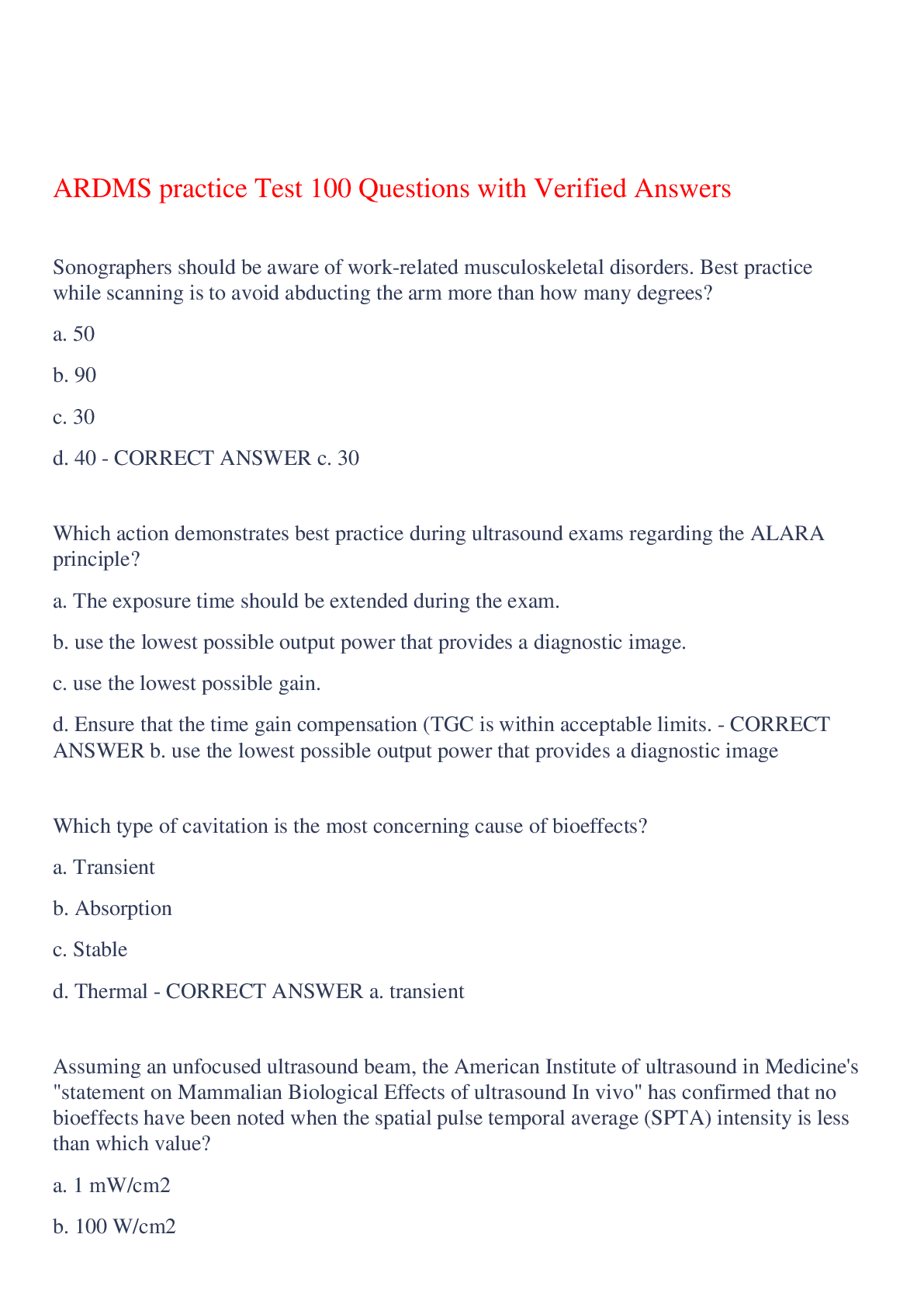
Buy this document to get the full access instantly
Instant Download Access after purchase
Add to cartInstant download
Reviews( 0 )
Document information
Connected school, study & course
About the document
Uploaded On
Aug 29, 2023
Number of pages
25
Written in
Additional information
This document has been written for:
Uploaded
Aug 29, 2023
Downloads
0
Views
111

















